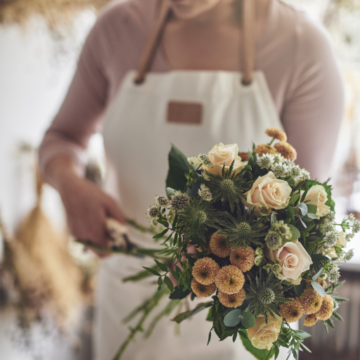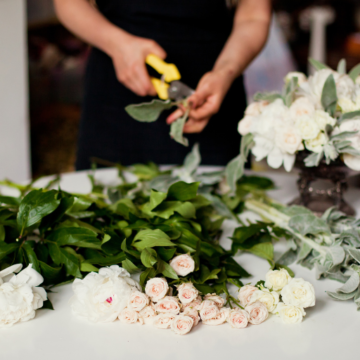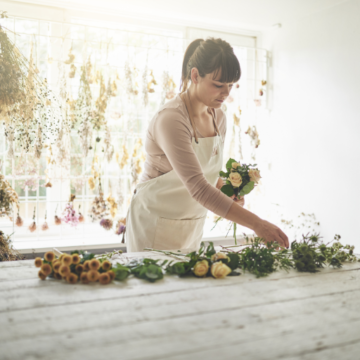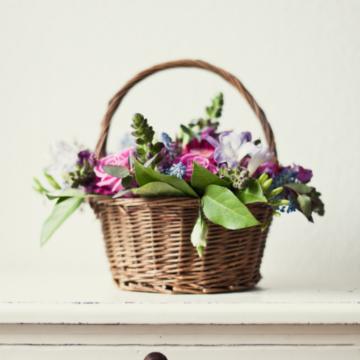Blog
Caring for your flower material: from market to customer

All flowers have different characteristics that demonstrate freshness. Your arrangements and cut flowers will last much longer if you use the freshest flowers and plant materials available to you, so it’s important to know what to look for, and how to care for that material properly.

What to check for
At the market or when you receive fresh stock, make sure you check the following:
- Green flower stems and vivid foliage, with no yellowing or slimy leaves present.
- Stiff but supple steams mean the material is well hydrated.
- When flowers or buds are present, make sure the majority of blooms are still closed. Buds that are open should be bright and fresh in appearance.
- Petals that are transparent or have protruding veins – this often indicates that the flowers have been cold stored for too long, which could result in the blooms failing to open, or that they may be dry.
- Buds with colour present. Tight buds without colour often mean that the blooms were cut prematurely.
- Flower petals should be bright, vivid colours and veins should not be visible.
- Select undamaged bunches or stems as holes or tears in leaves shorten their vase life and can attract bacteria.
As our product is from nature, we’re aware that not all materials we receive will be without imperfections. However, there may be times when stock should be returned to wholesalers. Building a strong, positive relationship with your wholesalers and growers will make this process easier, and minimise the likelihood of receiving poor-quality stock in the first place.

Caring for your material
Once you have received your fresh stock, whether you have purchased it from the market, collected it from the grower, or had it delivered to your floristry studio or shop, you must do the following to care for your stock:
- Using the tax invoice that you receive, make sure you check off all listed items, ensuring you have been given the correct amounts of each. At this time, you can also check the condition of the flowers and foliage, ensuring the quality of the product is 100%.
- Remove the plastic from each bunch. This allows a clear path of airflow to the blooms and stops condensation against the plastic, which may also cause the product to become mouldy or slimy with bacteria growth.
- Any foliage or leaves that sit below the water line should be removed. This keeps water fresh, minimises bacteria production, and will keep the stems clean and clear.
- Remove any broken or damaged flowers or leaves from within the bunches. This is for aesthetic reasons, but will also remove the potential for bruising or bacterial growth from within each bunch.
- Select a bucket of the correct height for the bunches, and fill a quarter to a third of the way full with clean, fresh water. Also, make sure any buckets you use have been thoroughly cleaned and correctly stored beforehand.
- Re-cut each of the stems on an angle, and place them into your bucket.
- Replenish the shop with your fresh stock, or place the buckets into a cool room for storage. As a general rule, flowers are best stored between 4-8ºC. For storing tropical varieties, this is approx. 12ºC or above.
This may seem like a long process, but it is essential to provide the appropriate care for the flowers and foliage to extend their vase life significantly.
Correct initial handling will also rehydrate the flowers, ensuring that the maximum water content is stored within the stems and leaves. This means that when the flowers are removed from the water (for delivery or when used for events where they will remain out of water for extended periods of time), they will be fully hydrated and last longer.

Maintaining your flowers
As you are working with fresh materials, it is essential to understand how to maintain the product’s freshness. By putting this knowledge into practice, it will maximise the lasting qualities of each flower and foliage. The responsibility of care is then passed onto the customer once the product is in their possession, so you need to effectively convey the maintenance requirements to your customer.
The best way to preserve healthy flowers is always to maintain fresh water in a clean vase and re-cut the stems every couple of days to enable a continuous flow of water up the stems.
The positioning of flowers is also important, as draughty and breezy areas (including air-conditioners) will dehydrate flowers, significantly reducing their lifespan. It is also important to keep flowers out of direct sunlight and prevent exposure to fireplaces and heaters (including air vents and outlets). Make sure you remove spent blooms and yellowing leaves to keep the remaining flowers looking fresh and beautiful.

Ready to learn more about proper flower care? Access your free 30 min Bloom in Business session here, where Bloom College founder, Yvette Timmins will take you through everything that a budding florist needs to know.